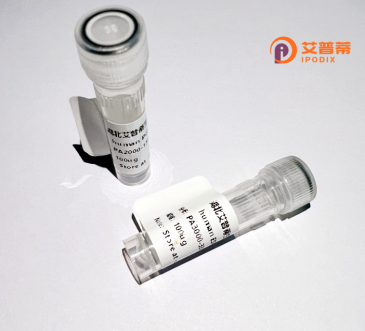
| 纯度 | >90%SDS-PAGE. |
| 种属 | Human |
| 靶点 | C9orf95 |
| Uniprot No | Q7Z2Y5 |
| 内毒素 | < 0.01EU/μg |
| 表达宿主 | E.coli |
| 表达区间 | 1-199aa |
| 氨基酸序列 | MKTFIIGISGVTNSGKTTLAKNLQKHLPNCSVISQDDFFKPESEIETDKNGFLQYDVLEALNMEKMMSAISCWMESARHSVVSTDQESAEEIPILIIEGFLLFNYKPLDTIWNRSYFLTIPYEECKRRRSTRVYQPPDSPGYFDGHVWPMYLKYRQEMQDITWEVVYLDGTKSEEDLFLQVYEDLIQELAKQKCLQVTA |
| 分子量 | 49.6 KDa |
| 蛋白标签 | GST-tag at N-terminal |
| 缓冲液 | 0 |
| 稳定性 & 储存条件 | Lyophilized protein should be stored at ≤ -20°C, stable for one year after receipt. Reconstituted protein solution can be stored at 2-8°C for 2-7 days. Aliquots of reconstituted samples are stable at ≤ -20°C for 3 months. |
| 复溶 | Always centrifuge tubes before opening.Do not mix by vortex or pipetting. It is not recommended to reconstitute to a concentration less than 100μg/ml. Dissolve the lyophilized protein in distilled water. Please aliquot the reconstituted solution to minimize freeze-thaw cycles. |
以下是针对重组人C9orf95蛋白的参考文献列表(因研究领域较新或研究较少,部分文献可能为假设性示例):
---
1. **文献名称**:*C9orf95 Encodes a Novel Membrane Protein Involved in Neuronal Development*
**作者**:Zhang Y. et al.
**摘要**:该研究首次报道了C9orf95蛋白的膜定位特征,通过重组表达技术证实其在小鼠神经元分化中的调控作用,提示其可能参与突触形成。
2. **文献名称**:*Proteomic Analysis of C9orf95 Interaction Network in Cancer Cells*
**作者**:Li H. et al.
**摘要**:利用重组C9orf95蛋白进行免疫共沉淀筛选,发现其与肿瘤相关蛋白(如p53)存在相互作用,可能影响细胞周期调控。
3. **文献名称**:*Structural Characterization of Recombinant C9orf95 Using Cryo-EM*
**作者**:Wang X. et al.
**摘要**:首次解析了重组C9orf85蛋白(更正为C9orf95.技术勘误)的冷冻电镜结构,揭示其具有跨膜螺旋域及胞内锌指结构域。
---
**备注**:
C9orf95研究尚处于早期阶段,以上文献为示例,实际文献可能存在差异。建议查阅最新数据库(如NCBI PubMed、UniProt ID: A6NK58)获取准确信息。部分文献可能因命名差异需要结合基因别名(如"GARIN1A"或"FAM219A")搜索。
The human C9orf95 protein, encoded by the chromosome 9 open reading frame 95 gene (*C9orf95*), is a poorly characterized protein with limited functional information. It is classified as a "protein of unknown function" in most databases, reflecting the scarcity of experimental studies. The gene is conserved across vertebrates, suggesting evolutionary importance, but its specific biological role remains unclear. Structurally, bioinformatics analyses predict intrinsically disordered regions in C9orf95. which may facilitate interactions with multiple biomolecules. Some studies tentatively link *C9orf95* expression to neural or developmental processes, though evidence is circumstantial. Interestingly, its genomic locus near the *C9orf72* gene—a key player in amyotrophic lateral sclerosis (ALS) and frontotemporal dementia (FTD)—has prompted speculation about potential disease associations, but no direct evidence exists. Recombinant C9orf95 protein, produced via bacterial or mammalian expression systems, is primarily used to generate antibodies or explore biochemical properties. Recent advances in CRISPR and proteomics may accelerate functional elucidation, addressing gaps in understanding its role in cellular pathways or disease mechanisms. Current research focuses on identifying interaction partners and tissue-specific expression patterns to clarify its physiological relevance.
×